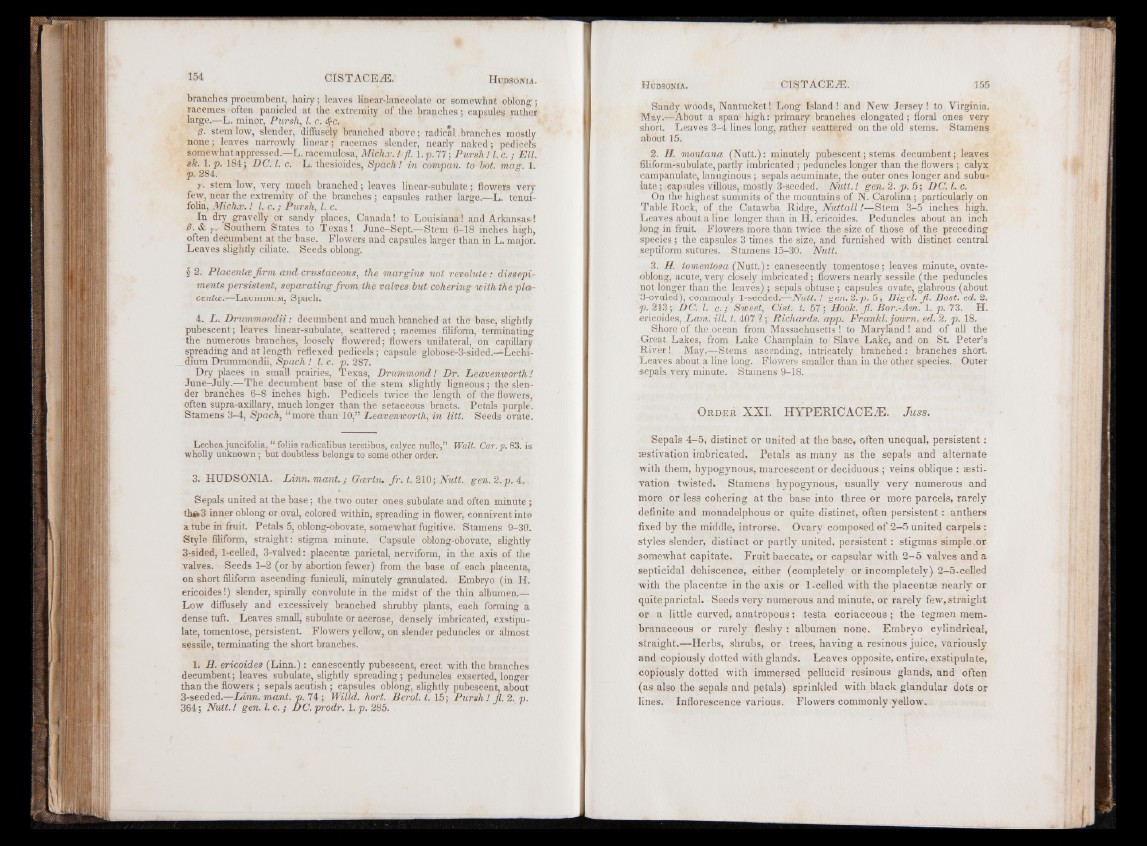
branches procumbent, hairy; leaves linear-lanceolate or somewhat oblong;
racemes often panicled at the extremity of the branches; capsules rather
large.—L. minor, Pursh, l. c. <fc.
/?• stem low, slender, diffusely branched above; radical .branches mostly
none; leaves narrowly linear; racemes slender, nearly naked; pedicels
somewhat appressed.—L. racemulosa, Michx.! fl. 1. p.77; Pursh! 1. c. ; Ell.
sic. l.p . 184; DC. 1. c. L. thesioides, Spach! in compan. to hot. mag. I.
p. 284.
r- stem low, very much branched; leaves linear-subulate; flowers very
few, near the extremity of the branches; capsules rather large.—L. tenui-
folia, Michx. ! 1. c .; Pursh, l. c.
In dry gravelly or sandy places, Canada! to Louisiana! and Arkansas!
/?. & y. Southern States to Texas ! June-Sept.—Stem 6-18 inches high,
often decumbent at the base. Flowers and capsules larger than in L. major.
Leaves slightly ciliate. Seeds oblong.
§ 2. Placenta firm and crustaceous, the margins not revolute: dissepiments
persistent, separating from the valves but cohering with the placenta.—
L echidium, Spach.
4. L. Drummondii: decumbent and much branched at the base, slightly
pubescent; leaves linear-subulate, scattered; racemes filiform, terminating
the numerous branches, loosely flowered; flowers unilateral, on capillary
spreading and at length reflexed pedicels; capsule globose-3-sided.—Lechidium
Drummondii, Spach ! 1. c. p. 287.
Dry places in small prairies, Texas, Drummond! Dr. Leavenworth!
June-July.—The decumbent base of the stem slightly ligneous; the slender
branches 6-8 inches high. Pedicels twice the length of the flowers,
often supra-axillary, much longer than the setaceous bracts. Petals purple.
Stamens 3-4, Spach, “more than 10,” Leavenworth, in litt. Seeds ovate.
Lechea juncifolia, “ foliis radicalibus teretibus, calyce nullo,” Walt. Car. p. 83. is
wholly unknown; but doubtless belongs to some other order.
3. HUDSONIA. Linn. mant.; Gartn. fir. t. 210; Nutt. gen. 2. p. 4.
Sepals united at the base; the two outer ones subulate and often minute ;
th&3 inner oblong or oval, colored within, spreading in flower, connivent into
a tube in fruit. Petals 5, oblong-obovate, somewhat fugitive. Stamens 9-30.
Style filiform, straight: stigma minute. Capsule oblong-obovate, slightly
3-sided, 1-celled, 3-valved: placentae parietal, nerviform, in the axis of the
valves. Seeds 1-2 (or by abortion fewer) from the base of each placenta,
on short filiform ascending funiculi, minutely granulated. Embryo (in H.
ericoides!) slender, spirally convolute in the midst of the thin albumen!—
Low diffusely and excessively branched shrubby plants, each forming a
dense tuft. Leaves small, subulate or acerose, densely imbricated, exstipu-
late, tomentose, persistent. Flowers yellow, on slender peduncles or almost
sessile, terminating the short branches. 1
1. H. ericoides (Linn.) : canescently pubescent, erect with the branches
decumbent; leaves subulate, slightly spreading; peduncles exserted, longer
than the flowers ; sepals acutish; capsules oblong, slightly pubescent, about
3-seeded.—Linn. mant. p. 74; Willd. hort. Berol. t. 15; P u rsh ! fl. 2. p.
364; Nutt.! gen. l.c .; DC.prodr. l.p . 285.
Sandy woods, Nantucket! Long Island! and New Jersey! to Virginia.
May.—About a span high: primary branches elongated; floral ones very
short. Leaves 3-4 lines long, rather scattered on the old stems. Stamens
about 15.
2. H. montana (Nutt.): minutely pubescent; stems decumbent; leaves
filiform-subulate, partly imbricated ; peduncles longer than the flowers ; calyx
campanulate, lanuginous ; sepals acuminate, the outer ones longer and subulate;
capsules villous, mostly 3-seeded. Nutt.! gen. 2. p. 5; DC. 1. c.
On the highest summits of the mountains of N. Carolina; particularly on
Table Rock, of the Catawba Ridge, N u tta ll!—Stem 3-5 inches high.
Leaves about a line longer than in H. ericoides. Peduncles about an inch
long in fruit Flowers more than twice the size of those of the preceding
species; the capsules 3 times the size, and furnished with distinct central
septiform sutures. Stamens 15-30, Nutt.
3. H. tomentosa (Nutt.): canescently tomentose; leaves minute, ovate-
oblong, acute, very closely imbricated; flowers nearly sessile (the peduncles
not longer than the leaves) ; sepals obtuse; capsules ovate, glabrous (about
3-ovuled), commonly 1-seeded.-—Nutt. ! gen. 2.p. 5; Bigel. fl. Bost. ed. 2.
p. 213; DC. 1. c.; Sweet, Cist. t. 57 ; Hook. fl. Bor.-Am. 1. p. 73. H.
ericoides, Lam. ill. t. 407 ?; Richards, app. Frankl. journ. ed. 2. p. 18.
Shore of the ocean from Massachusetts! to Maryland! and o f all the
Great Lakes, from Lake Champlain to Slave Lake, and on St. Peter’s
River! May.—Stems ascending, intricately branched: branches short.
Leaves about a line long. Flowers smaller than in the other species. Outer
sepals very minute. Stamens 9-18.
Or d e r XXI. HYPERICACEiE. Juss.
Sepals 4 -5 , distinct or united at the base, often unequal, persistent :
aestivation imbricated. Petals as many as the sepals and alternate
with them, hypogynous, marcescent or deciduous ; veins oblique : aestivation
twisted. Stamens hypogynous, usually very numerous and
more or less cohering at the base into three or more parcels, rarely
definite and monadelphous or quite distinct, often persistent: anthers
fixed by the middle, introrse. Ovary composed o f 2—5 united carpels:
styles slender, distinct or partly united, persistent: stigmas simple .or
somewhat capitate. Fruit baccate, or capsular with 2 - 5 valves and a
septicidal dehiscence, either (completely or incompletely) 2-5-celIed
with the placentae in the axis or 1 -celled with the placentae nearly or
quite parietal. Seeds very numerous and minute, or rarely few, straight
or a little curved, anatropous: testa coriaceous ; the tegmen membranaceous
or rarely fleshy : albumen none. Embryo cylindrical,
straight.— Herbs, shrubs, or trees, having a resinous juice, variously
and copiously dotted with glands. Leaves opposite, entire, exstipulate,
copiously dotted with immersed pellucid resinous glands, and often
(as also the sepals and petals) sprinkled with black glandular dots or
lines. Inflorescence various. Flowers commonly yellow.